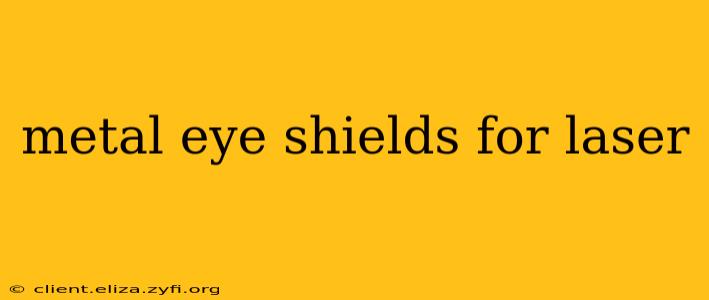Laser safety is paramount, and protecting your eyes from harmful laser radiation is critical. While various eye protection options exist, metal eye shields offer a unique combination of durability, effectiveness, and versatility. This guide delves into the world of metal eye shields for laser applications, exploring their features, benefits, limitations, and considerations for selection.
What are Metal Eye Shields for Lasers?
Metal eye shields for lasers are specialized protective eyewear designed to attenuate or block specific wavelengths of laser light. Unlike some plastic or glass alternatives, these shields typically utilize metal alloys or metal-coated substrates to achieve high optical density (OD) ratings. This means they can effectively absorb or reflect a substantial portion of the laser energy, preventing it from reaching the eyes. The specific metal and its treatment determine the shield's effectiveness against different laser types and wavelengths.
What are the Different Types of Metal Eye Shields?
Several types of metal eye shields cater to various laser applications. While the exact composition isn't always publicly available due to proprietary manufacturing processes, common features include:
- Welding shields: Often made of heavy-gauge steel or aluminum, these shields prioritize protection from the intense light and spatter associated with welding, but may not offer specific protection against laser radiation unless specifically designed.
- Laser-specific shields: These are engineered for specific laser wavelengths and power levels, offering precisely calibrated OD ratings. They might incorporate specialized coatings or alloys for optimal performance.
- Custom-designed shields: For high-power laser applications or unique environmental conditions, custom-designed metal shields can be manufactured to meet very specific requirements.
How Effective are Metal Eye Shields?
The effectiveness of a metal eye shield depends on several factors:
- The wavelength of the laser: Different metals absorb or reflect different wavelengths more efficiently.
- The power of the laser: Higher-power lasers require shields with higher OD ratings.
- The duration of exposure: Even a well-designed shield might not provide adequate protection against prolonged exposure to high-power lasers.
- The shield's condition: Scratches or damage to the shield can significantly reduce its effectiveness.
What are the Benefits of Using Metal Eye Shields for Lasers?
Metal eye shields offer several advantages over other eye protection options:
- High durability: Metal shields are significantly more resistant to damage and scratching than plastic or glass alternatives.
- High optical density (OD) ratings: They can achieve very high OD ratings, providing superior protection against intense laser radiation.
- Resistance to heat: Metal shields can better withstand the heat generated by some lasers, especially in high-power applications.
- Long lifespan: With proper care and storage, metal eye shields can last for a considerable amount of time.
What are the Limitations of Metal Eye Shields?
While offering excellent protection, metal eye shields also have some limitations:
- Weight: Metal shields tend to be heavier than other types of laser safety eyewear.
- Cost: They are typically more expensive than plastic or glass alternatives.
- Limited field of vision: The design of some metal shields may restrict the user's field of vision compared to lighter eyewear.
- Potential for reflection: While designed to minimize it, some reflection can still occur, depending on the laser's properties and the shield's surface.
What types of lasers require metal eye shields?
The need for metal eye shields depends primarily on the laser's power and wavelength. High-power lasers, especially those operating in the infrared or ultraviolet ranges, frequently necessitate metal eye protection. Consult the laser's safety manual and relevant safety standards for guidance.
How do I choose the right metal eye shield?
Selecting the appropriate metal eye shield involves careful consideration of the laser's specifications (wavelength, power, and beam characteristics), the anticipated exposure duration, and the specific requirements of the application. Consulting with a laser safety expert is highly recommended.
How should I care for my metal eye shields?
Proper care extends the lifespan of metal eye shields. Always follow the manufacturer's instructions for cleaning and storage. Regular inspection for damage is critical. Never use damaged shields.
Conclusion
Metal eye shields offer robust protection against the hazards of laser radiation. While their higher cost and weight are drawbacks, their superior durability and high OD ratings make them the preferred choice for many high-power or demanding laser applications. Prioritize safety by selecting shields appropriate for the specific laser and application, and always adhere to safe laser operating practices. Remember that this information is for general guidance, and professional consultation is recommended for specific applications and risk assessments.
